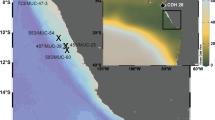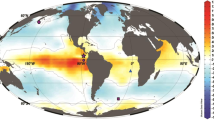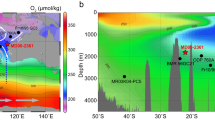Abstract
During the last and penultimate glacial maxima, atmospheric CO2 concentrations were lower than present, possibly in part because of increased storage of respired carbon in the deep oceans1. The amount of respired carbon present in a water mass can be calculated from its oxygen content through apparent oxygen utilization; the oxygen content can in turn be calculated from the carbon isotope gradient within the sediment column2. Here we analyse the shells of benthic foraminifera occurring at the sediment surface and the oxic/anoxic interface on the Portuguese Margin to reconstruct the carbon isotope gradient and hence bottom-water oxygenation over the past 150,000 years. We find that bottom-water oxygen concentrations were 45 and 65 μmol kg−1 lower than present during the last and penultimate glacial maxima, respectively. We calculate that concentrations of remineralized organic carbon were at least twice as high as today during the glacial maxima. We attribute these changes to decreased ventilation linked to a reorganization of ocean circulation3 and a strengthened global biological pump4. If the respired carbon pool was of a similar size throughout the entire glacial deep Atlantic basin, then this sink could account for 15 and 20 per cent of the glacial drawdown during the last and penultimate glacial maxima.
This is a preview of subscription content, access via your institution
Access options
Subscribe to this journal
Receive 12 print issues and online access
$259.00 per year
only $21.58 per issue
Buy this article
- Purchase on Springer Link
- Instant access to full article PDF
Prices may be subject to local taxes which are calculated during checkout


Similar content being viewed by others
References
Sigman, D. A. & Boyle, E. A. Glacial/interglacial variations in atmospheric carbon dioxide. Nature 407, 859–869 (2000).
McCorkle, D. C. & Emerson, S. R. The relationship between pore water carbon isotopic composition and bottom water oxygen concentration. Geochim. Cosmochim. Acta 52, 1169–1176 (1988).
McManus, J. F., Francois, R., Gherardi, J. M., Keigwin, L. D. & Brown-Leger, S. Collapse and rapid resumption of Atlantic meridional circulation linked to deglacial climate changes. Nature 428, 834–837 (2004).
Kohfeld, K. E., Le Quéré, C., Harrison, S. P. & Anderson, R. F. Role of marine biology in glacial–interglacial CO2 cycles. Science 308, 74–78 (2005).
Anderson, L. A. & Sarmiento, J. L. Redfield ratios of remineralization determined by nutrient data analysis. Glob. Biogeochem. Cycles 8, 65–80 (1994).
Sarmiento, J. L. & Gruber, N. Ocean Biogeochemical Dynamics (Princeton Univ. Press, 2006).
Gehlen, M., Mucci, A. & Boudreau, B. Modelling the distribution of stable carbon isotopes in porewaters of deep-sea sediments. Geochim. Cosmochim. Acta 63, 2763–2773 (1999).
McCorkle, D. C., Keigwin, L. C., Corliss, B. H. & Emerson, S. R. The influence of microhabitats on the carbon isotopic composition of deep-sea benthic foraminifera. Paleoceanography 5, 161–185 (1990).
Schmiedl, G. & Mackensen, A. Multispecies stable isotopes of benthic foraminifera reveal past changes in organic matter decomposition and deepwater oxygenation in the Arabian Sea. Paleoceanography 21, PA4213 (2006).
Fontanier, C. et al. Live benthic foraminiferal faunas from the Bay of Biscay: Faunal density, composition, and microhabitats. Deep-Sea Res. I 49, 751–785 (2002).
Geslin, E., Heinz, O., Jorissen, F. & Hemleben, Ch. Migratory responses of deep-sea benthic foraminifera to variable oxygen conditions: Laboratory investigations. Mar. Micropaleontol. 53, 227–243 (2004).
Mackensen, A. in Biogeochemical Controls on Palaeoceanographic Environmental Proxies Vol. 303 (eds Austin, W. E. N. & James, R. H.) 121–133 (Geological Society, Special Publications, 2008).
Shackleton, N. J., Hall, M. A. & Vincent, E. Phase relationships between millennial-scale events 64,000–24,000 years ago. Paleoceanography 15, 565–569 (2000).
Shackleton, N. J. et al. Stable carbon and oxygen isotope ratios of benthic foraminifera from sediment core MD95-2042 on the Iberian margin, North Atlantic. http://dx.doi.org/10.1594/PANGAEA.58220 (2000).
Shackleton, N. J., Fairbanks, R. G., Chiu, T. & Parrenin, F. Absolute calibration of the Greenland time scale: Implications for Antarctic time scales and for Δ14C. Quat. Sci. Rev. 23, 1513–1522 (2004).
Jorissen, F. J., de Stigter, H. C. & Widmark, J. G. V. A conceptual model explaining benthic foraminiferal microhabitats. Mar. Micropaleontol. 26, 3–15 (1995).
Key, R. M. et al. A global ocean carbon climatology: Results from the Global Data Analysis Project (GLODAP). Glob. Biogeochem. Cycles 18, GB4031 (2004).
Broecker, W. S. Massive iceberg discharges as triggers for global climate change. Nature 372, 421–424 (1994).
Adkins, J. S., McIntyre, K. & Schrag, D. P. The salinity, temperature and δ18O of the glacial deep ocean. Science 298, 1769–1773 (2002).
Skinner, L. C. & Shackleton, N. J. Rapid transient changes in northeast Atlantic deep water ventilation age across termination I. Paleoceanography 19, PA2005 (2004).
Curry, W. B. & Oppo, D. W. Glacial water mass geometry and the distribution of δ13C of ΣCO2 in the western Atlantic Ocean. Paleoceanography 20, PA1017 (2005).
Gutjahr, M., Frank, M., Stirling, C. H., Keigwin, L. D. & Halliday, A. N. Tracing the Nd isotope evolution of North Atlantic Deep and intermediate waters in the western North Atlantic since the Last Glacial Maximum from Blake Ridge sediments. Earth Planet. Sci. Lett. 266, 61–77 (2008).
Toggweiler, J. R. Variation of atmospheric CO2 by ventilation of the ocean’s deepest water. Paleoceanography 14, 571–588 (1999).
Stephens, B. B. & Keeling, R. F. The influence of Antarctic sea ice on glacial–interglacial CO2 variations. Nature 404, 171–174 (2000).
Martin, J. H. Glacial–interglacial CO2 change: The iron hypothesis. Paleoceanography 6, 1–13 (1990).
Martínez-García, A. et al. Iron fertilization of the subantarctic ocean during the last ice age. Science 343, 1347–1350 (2014).
Debelius, B., Gómez-Parra, A. & Forja, J. M. Oxygen solubility in evaporated seawater as a function of temperature and salinity. Hydrobiologia 632, 157–165 (2009).
Ito, T., Marshall, J. & Follows, M. What controls the uptake of transient tracers in the Southern Ocean? Glob. Biogeochem. Cycles 18, GB2021 (2004).
Parmentier, F. J. et al. The impact of lower sea-ice extent on Arctic greenhouse-gas exchange. Nature Clim. Change 17, 195–202 (2013).
Jaccard, S. L. & Galbraith, E. D. Large climate-driven changes of oceanic oxygen concentrations during the last deglaciation. Nature Geosci. 5, 151–156 (2012).
Acknowledgements
This work is supported by UK Natural Environment Research Council (NERC) grant NE/I020563/1 (to B.A.A.H.). This research used samples and/or data provided by the Ocean Drilling Program (ODP). ODP is sponsored by the US National Science Foundation and participating countries (Natural Environment Research Council in the UK) under management of the Joint Oceanographic Institutions (JOI).
Author information
Authors and Affiliations
Contributions
B.A.A.H. conceived and coordinated the work, carried out data analyses and synthesis, and constructed the figures. B.A.A.H. wrote the paper with contributions from the other co-authors.
Corresponding author
Ethics declarations
Competing interests
The authors declare no competing financial interests.
Supplementary information
Supplementary Information
Supplementary Information (PDF 504 kb)
Rights and permissions
About this article
Cite this article
Hoogakker, B., Elderfield, H., Schmiedl, G. et al. Glacial–interglacial changes in bottom-water oxygen content on the Portuguese margin. Nature Geosci 8, 40–43 (2015). https://doi.org/10.1038/ngeo2317
Received:
Accepted:
Published:
Issue Date:
DOI: https://doi.org/10.1038/ngeo2317
This article is cited by
-
Southern Ocean glacial conditions and their influence on deglacial events
Nature Reviews Earth & Environment (2023)
-
A global synthesis of high-resolution stable isotope data from benthic foraminifera of the last deglaciation
Scientific Data (2023)
-
Indian Ocean glacial deoxygenation and respired carbon accumulation during mid-late Quaternary ice ages
Nature Communications (2023)
-
Arctic deep-water anoxia and its potential role for ocean carbon sink during glacial periods
Communications Earth & Environment (2023)
-
Planktonic foraminifera organic carbon isotopes as archives of upper ocean carbon cycling
Nature Communications (2022)



